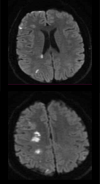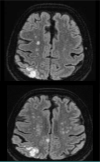Diagnosis and treatment of Watershed strokes: a narrative review
- PMID: 37675172
- PMCID: PMC10478671
- DOI: 10.25122/jml-2023-0127
Diagnosis and treatment of Watershed strokes: a narrative review
Abstract
Watershed strokes have been described previously as ischemic strokes located in vulnerable border zones between brain tissue supplied by the anterior, posterior, and middle cerebral arteries in the distal junction between two non-anastomotic arterial territories. Ischemic strokes in border zones are well-recognized entities and well-described in terms of imaging features, but the pathophysiological mechanism of brain injury production is not fully defined. Border zone ischemia is caused by cerebral hypoperfusion through decreased cerebral blood flow and arterial embolism in unstable atheroma plaque. It is often difficult to say which mechanisms are fully responsible for producing cerebral ischemic lesions. This review aimed to highlight the imaging aspect of watershed strokes and to correlate the clinical characteristics of this type of stroke with the diagnostic algorithm for optimal therapeutic management. Neurologists should promptly recognize this type of stroke and investigate its etiology in the shortest possible time.
Keywords: ACA - anterior cerebral artery; BMT - best medical treatment; CAS - carotid artery stentings; CBF - cerebral blood flow; CBV - cerebral blood volume; CBZ - cortical border-zone; CEA - carotid endarterectomy; CT - computer tomography; DWI - diffusion-weighted imaging; ECST - European Carotid Surgery Trial; FLAIR - fluid attenuation inversion recovery; IBZ - internal border-zone; ICA - internal carotid artery; LVO - large vessel oclussion; MCA - middle cerebral artery; MRI - magnetic resonance imaging; MS - multiple sclerosis; NIHSS - National Institute of Health Stroke Scale; PCA - posterior cerebral artery; PET - positron emission tomography; SPECT - single photon emission tomography; TIA - transient ischemic attack; TOF - time of flight; WI - Watershed infarcts; Watershed infarcts; carotid stenosis; hypoperfusion; ischemic stroke.
©2023 JOURNAL of MEDICINE and LIFE.
Conflict of interest statement
The authors declare no conflict of interest.
Figures









References
Publication types
MeSH terms
LinkOut - more resources
Full Text Sources
Medical
Miscellaneous
